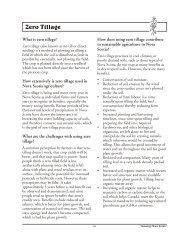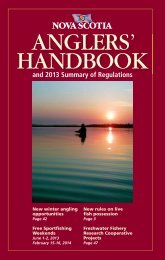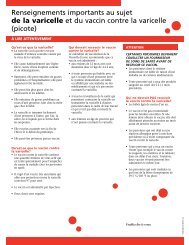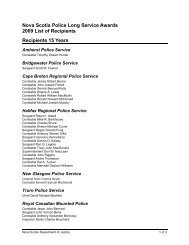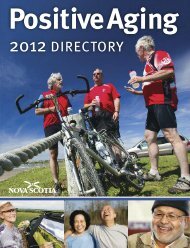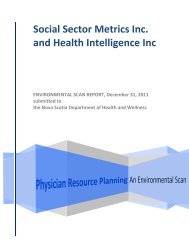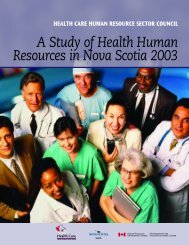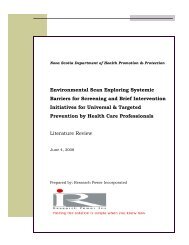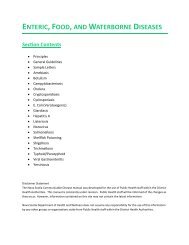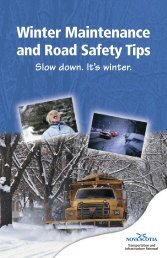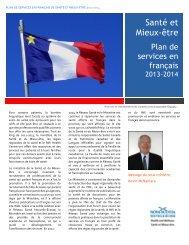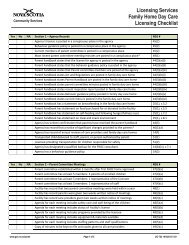Nova Scotia's Renewed Injury Prevention Strategy - Government of ...
Nova Scotia's Renewed Injury Prevention Strategy - Government of ...
Nova Scotia's Renewed Injury Prevention Strategy - Government of ...
- No tags were found...
You also want an ePaper? Increase the reach of your titles
YUMPU automatically turns print PDFs into web optimized ePapers that Google loves.
Taking It to the Next Level <strong>Nova</strong> Scotia’s <strong>Renewed</strong> <strong>Injury</strong> <strong>Prevention</strong> <strong>Strategy</strong>38EnforcementEnforcement refers to the creation and enforcement<strong>of</strong> laws, regulations, procedures, and policiesdesigned to reduce injuries. The notion <strong>of</strong>enforcement occurs at many levels: government,institutions, organizations, and even families.Enforcement seeks to effect changes in behaviourand shift the norms and culture <strong>of</strong> society towardgreater prevention <strong>of</strong> injury. Enforcement as a toolfor injury prevention is embedded with the ideas <strong>of</strong>creating supportive environments, reorientingservices, and developing healthy public policies.Examples <strong>of</strong> enforcement<strong>Government</strong>—Occupational health and safetylaws and enforcement measuresInstitutions—Rules that prohibit throwingsnowballs at schoolOrganizations—Procedures for handling adangerous product in the workplaceFamilies—Rules for teenagers about using thefamily carEngineeringEngineering seeks to alter the social and physicalenvironments as well as the characteristics <strong>of</strong>products (e.g., vehicles, safety equipment) todecrease the risk <strong>of</strong> injury. The concept <strong>of</strong>engineering is reflected in health promotion throughhealthy public policies, creating supportiveenvironments, and reorienting services.Achieving healthy communities requires us toemploy a range <strong>of</strong> strategies that draw oneducation, enforcement, and engineering. Theseintegrated approaches remind us to focus attentionon these factors within the economic, social, andphysical environments <strong>of</strong> individuals, families, andcommunities. The three E’s do not stand alone. Theyare part <strong>of</strong> a comprehensive framework forpromoting health and therefore preventing injuries.Balancing RiskMost injury prevention advocates would agree thatwe cannot—and should not—protect <strong>Nova</strong>Scotians from all the dangers they are exposed to ineveryday living. This would be neither practical norwise. Instead, this strategy recognizes that risk is apart <strong>of</strong> everyday life. Taking healthy risks helps tobuild positive decision-making skills and strengthensself-esteem through a sense <strong>of</strong> accomplishmentwhen a risk is overcome.Allowing people, particularly youth, to engage inpositive risk-taking helps develop resilient adultswith the skills to cope with challenging situations.Through this strategy we must promote positive risktakingand work with partners to provide positivesubstitutes for negative risks such as harmful use <strong>of</strong>drugs, binge drinking, or dangerous thrill-seeking.Helping <strong>Nova</strong> Scotians recognize where risks forinjuries occur and providing them with good policiesand supportive environments that mitigate theserisks will prevent injury.We need to create supportive environments andpolicies that keep people safe but still encouragethem to engage in positive risk-taking. Providing themeans (e.g., safety equipment or training) and safesettings (e.g., roads, skate parks, playgrounds) forpeople to participate in positive risk is encouragedthrough this strategy.Finding the right balanceToo much risk and we endanger a child. Toolittle risk and we fail to provide a child withhealthy opportunities for growth andpsychological development. 41



